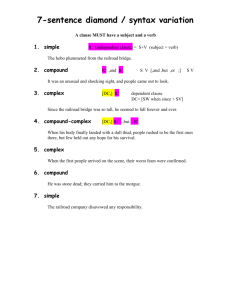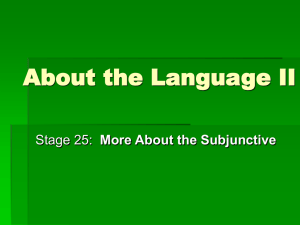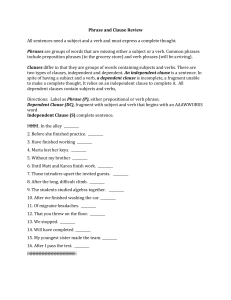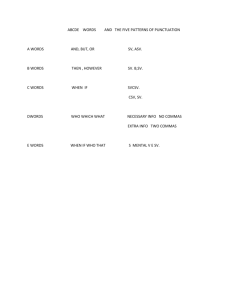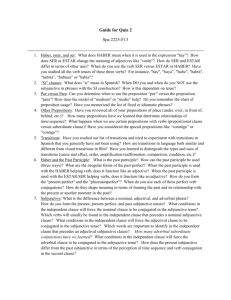the subjunctive mood: summary of forms and
advertisement
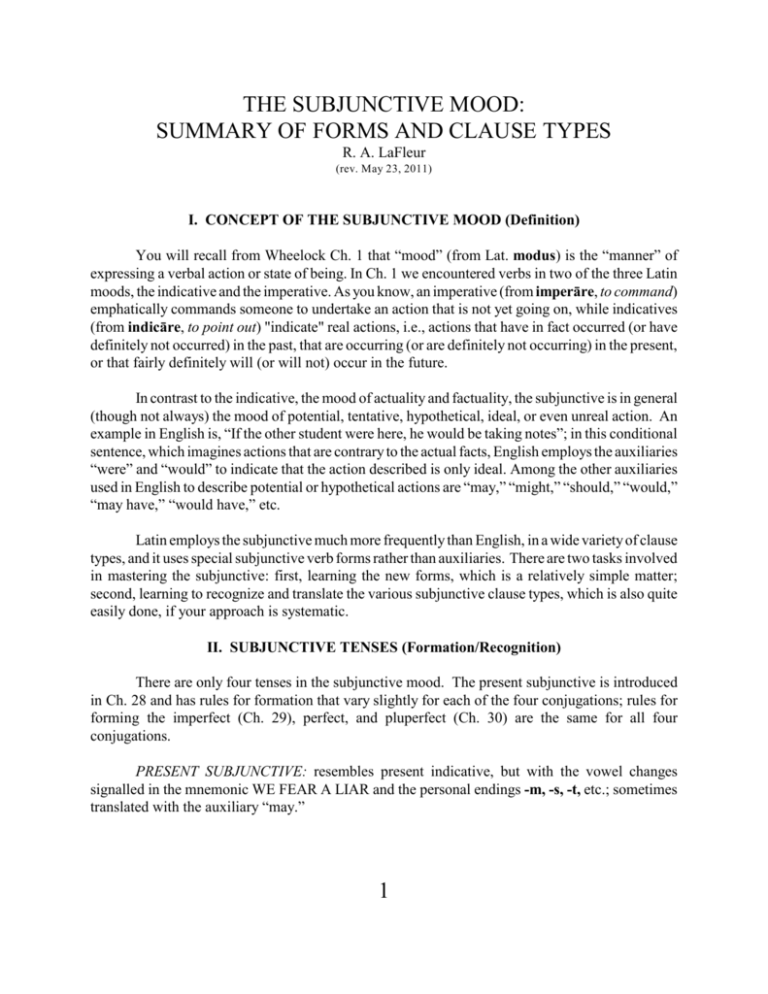
THE SUBJUNCTIVE MOOD: SUMMARY OF FORMS AND CLAUSE TYPES R. A. LaFleur (rev. May 23, 2011) I. CONCEPT OF THE SUBJUNCTIVE MOOD (Definition) You will recall from Wheelock Ch. 1 that “mood” (from Lat. modus) is the “manner” of expressing a verbal action or state of being. In Ch. 1 we encountered verbs in two of the three Latin moods, the indicative and the imperative. As you know, an imperative (from imperāre, to command) emphatically commands someone to undertake an action that is not yet going on, while indicatives (from indicāre, to point out) "indicate" real actions, i.e., actions that have in fact occurred (or have definitely not occurred) in the past, that are occurring (or are definitely not occurring) in the present, or that fairly definitely will (or will not) occur in the future. In contrast to the indicative, the mood of actuality and factuality, the subjunctive is in general (though not always) the mood of potential, tentative, hypothetical, ideal, or even unreal action. An example in English is, “If the other student were here, he would be taking notes”; in this conditional sentence, which imagines actions that are contrary to the actual facts, English employs the auxiliaries “were” and “would” to indicate that the action described is only ideal. Among the other auxiliaries used in English to describe potential or hypothetical actions are “may,” “might,” “should,” “would,” “may have,” “would have,” etc. Latin employs the subjunctive much more frequently than English, in a wide variety of clause types, and it uses special subjunctive verb forms rather than auxiliaries. There are two tasks involved in mastering the subjunctive: first, learning the new forms, which is a relatively simple matter; second, learning to recognize and translate the various subjunctive clause types, which is also quite easily done, if your approach is systematic. II. SUBJUNCTIVE TENSES (Formation/Recognition) There are only four tenses in the subjunctive mood. The present subjunctive is introduced in Ch. 28 and has rules for formation that vary slightly for each of the four conjugations; rules for forming the imperfect (Ch. 29), perfect, and pluperfect (Ch. 30) are the same for all four conjugations. PRESENT SUBJUNCTIVE: resembles present indicative, but with the vowel changes signalled in the mnemonic WE FEAR A LIAR and the personal endings -m, -s, -t, etc.; sometimes translated with the auxiliary “may.” 1 IMPERFECT SUBJUNCTIVE: = 2nd principal part (present active infinitive), with the final -e lengthened, plus personal endings -m, -s, -t, etc.; sometimes translated with “might.” PERFECT SUBJUNCTIVE: ACTIVE = the perfect active stem (from 3rd principal part) + -erim, -erīs, etc. (resembles future perfect indicative except -erim not -erō and -ī- long in -erīs, erīmus, -erītis; sometimes translated with “may have.” PASSIVE = perfect passive participle (4th principal part) + sim, sīs, etc. (i.e., subjunctive equivalent of sum); sometimes translated with “may have been.” PLUPERFECT SUBJUNCTIVE: ACTIVE = perfect active infinitive (from 3rd principal part) + -m, -s, -t, etc.; sometimes translated with “might have.” PASSIVE = perfect passive participle (4th principal part) + essem, essēs, etc. (i.e., subjunctive equivalent of eram); sometimes translated with “might have been.” SYNOPSIS The following synopsis provides a useful overview of the entire Latin verb system, including all four subjunctive mood tenses: Indicative Mood Act. Pres. Fut. Impf. Perf. Fut.Perf. Plupf. dūcit dūcet dūcēbat dūxit dūxerit d ū x e r a t dūcētur dūcēbātur ductus est ductus erit ductus erat Pres. Fut. Impf. Perf. Fut.Perf. Plupf. dūcat ---- dūceret dūxerit ---- dūxisset ---- dūcerētur ductus sit ---- ductus esset Pass. dūcitur Subjunctive Mood Act. Pass. dūcātur 2 III. SUBJUNCTIVE CLAUSE TYPES In Wheelock you are introduced to a series of subjunctive clause types: jussive and purpose clauses (Ch. 28), result clauses (29), indirect questions (30), cum clauses (31), proviso clauses (32), conditions (33, with three distinct subjunctive types), jussive noun clauses (36), relative clauses of characteristic (38), and fear clauses (40). You should systematically learn three details for each: (1) its definition, (2) how to recognize it in a Latin sentence, and (3) how to translate it into English. 1. JUSSIVE SUBJUNCTIVES (Wheelock Ch. 28) Definition: an independent (main) clause expressing a command or exhortation (the only use of the subjunctive in a main clause formally introduced in Wheelock). E.g., “Let us study this lesson carefully.” Recognition: easily recognized, since the sentence's main verb (and often its only verb) is subjunctive; negatives are introduced by nē. Translation: let (sometimes may or should) is the English auxiliary used in translation, followed by the subject noun or pronoun (in the objective case, i.e., me, us, him, her, it, them). E.g., Cōgitēm nunc dē hāc rē, et tum nōn errābō. Let me now think about this matter, and then I will not make a mistake. Discipulus discat aut discēdat. Let the student either learn or leave. Discāmus magnā cum dēlectātiōne linguam Latīnam. Let us learn the Latin language with great delight. Nē id faciāmus. Let us not do this. 2. PURPOSE CLAUSES (Wheelock Ch. 28) Definition: a subordinate clause explaining the purpose of the action in the main clause, i.e., answering the question “why?” E.g., “we study Latin so that we may learn more about ancient Rome” or “we study Latin to improve our English.” Recognition: introduced by ut if purpose is stated positively, by nē if negative, with a subjunctive verb at the end, and answering the question “why?” Translation: there are often several options, including translating ut + the subjunctive together as an infinitive; other more formal options include using the auxiliary “may” for the present subjunctive and “might” for the imperfect. E.g.: 3 Hic dīcit ut eōs iuvet. He says this to help them. in order to help them. that he may help them. so that he may help them. in order that he may help them. The first two translation options given above are more colloquial, the others more formal. Hic dīxit ut eōs iuvāret. He said this to help them. in order to help them. that he might help them. so that he might help them. in order that he might help them. 3. RESULT CLAUSES (Wheelock Ch. 29) Definition: a subordinate clause explaining the result of the action in the main clause, i.e., answering the question “what is (was) the outcome?” E.g., “It is raining so hard that the streets are flooding” and “Vicky studied Latin so diligently that she knew it like a Roman.” Recognition: introduced by ut and concludes with a subjunctive verb; if negative, contains some negative word (nōn, nēmō, numquam, etc.); and answers the question “what is (was) the outcome?” Main clause usually contains a signal word indicating degree (tam, tantus, ita, sīc). Easily distinguished from a purpose clause by sense and context, by the signal word in the main clause, and, if negative, by the presence of some negative word within the clause (vs. a negative purpose clause, which is introduced by nē). Translation: translate ut as “that” and translate the subjunctive as an indicative, i.e., without an auxiliary (no “may” or “might”). E.g.: Tam multum studet ut Latīnam bene discat. He studies so much that he learns (is learning) Latin well. Tam multum studēbat ut Latīnam bene disceret. He studied so much that he learned Latin well. 4. INDIRECT QUESTIONS (Wheelock Ch. 30) Definition: a subordinate clause which reports some question indirectly, i.e., not via a direct quotation. E.g., “They asked what Gaius was doing” vs. “They asked, `What is Gaius doing?'” 4 (comparable in conception to an indirect statement, which reports indirectly, not a question, but some affirmative statement and uses an infinitive with accusative subject, not a subjunctive). Recognition: introduced by an interrogative word (quis, quid, cūr, ubi, utrum...an [whether...or], -ne [attached to the clause's first word, = whether]) and ends with a subjunctive; the verb in the main clause is ordinarily a verb of speech, mental activity, or sense perception (the same verbs that introduce indirect statements, listed in Ch. 25) Translation: translate the subjunctive as an indicative (as with result clauses, no “may” or “might”). Compare the following direct and indirect questions: Quid Gaius facit? Rogant quid Gaius faciat. Rogāvērunt quid Gaius faceret. What is Gaius doing? They ask what Gaius is doing. They asked what Gaius was doing. Quid Gaius fēcit? Rogant quid Gaius fēcerit. Rogāvērunt quid Gaius fēcisset. What did Gaius do? They ask what Gaius did. They asked what Gaius had done. Quid Gaius faciet? Rogant quid Gaius factūrus sit. Rogāvērunt quid Gaius factūrus esset. What will Gaius do? They ask what Gaius will do (is about to do). They asked what Gaius would do (was about to do. FUTURE ACTIVE PERIPHRASTIC: Factūrus sit/esset in the last two examples is the “future active periphrastic,” occasionally employed to indicate future time in certain types of clauses, including indirect questions (Wheelock, p. 204). SEQUENCE OF TENSES: The above examples clearly indicate the rule for sequence of tenses, i.e., a primary tense main verb (present or future) is followed by a primary tense subjunctive (present = time same or later than main verb, perfect = time before main verb), a secondary (historical) tense main verb (any past tense) is followed by a secondary tense subjunctive (imperfect = time same or later than main verb, pluperfect = time before main verb); see Wheelock pp. 204–05. 5-7. Cum CLAUSES (Wheelock Ch. 31) Definition: a subordinate clause introduced by cum meaning when/since/although and describing an action somehow associated with the action in the main clause. FOUR TYPES: TEMPORAL/cum = “when” = an action occurring at the same exact time as the action in the main clause; CIRCUMSTANTIAL/cum = “when” = some general circumstances under which action in 5 main clause occurred; CAUSAL/cum = “since” = a cause/reason for action in main clause; ADVERSATIVE/cum = “although” = an action contrary to what might be expected, in view of the action in the main clause. E.g., When he saw her that day, he was happy (temporal); when he studies, he does well (circumstantial); since he studied hard, he did well (causal); although he studied hard, nevertheless he did not do well (adversative). Recognition: introduced by cum (WITHOUT an ablative noun following—in which case cum would be functioning as a preposition = “with”), with a verb—either subjunctive or indicative—at the end, and usually set off from the main clause by comma(s); of the four types, the TEMPORAL is recognized by its INDICATIVE verb and the ADVERSATIVE is usually recognized by the presence of tamen (“nevertheless”) in the main clause; the other two types are recognized by context. Translation: translate the verb in ALL FOUR TYPES as an INDICATIVE (i.e., with NO AUXILIARY such as “may” or “might”); translate cum as: “when,” if the verb is indicative; “although,” if tamen is in the main clause; otherwise as “when” or “since,” depending on context. E.g.: INDICATIVE TYPE Cum TEMPORAL Cum in urbem illō diē vēnit, tē vīdit. WHEN he CAME into the city that day, he saw you. SUBJUNCTIVE TYPES: 5. Cum CIRCUMSTANTIAL Cum studeat, bene agit. WHEN (whenever) he STUDIES, he does well. 6. Cum CAUSAL Cum hoc scīret, potuit eōs iuvāre. SINCE he KNEW this, he was able to help them. 7. Cum ADVERSATIVE Cum hoc scīret, tamen nōn potuit eōs iuvāre. ALTHOUGH he KNEW this, he was nevertheless unable to help them. 8. PROVISO CLAUSES (Wheelock Ch. 32) Definition: a subordinate clause introduced by dummodo meaning “provided that/so long as” and describing an action on which the action in the main clause is contingent. E.g., “So long as he sees her tomorrow, he will be happy”; “Provided that you enjoy Latin, you won't mind studying.” 6 Recognition: introduced by dummodo, with a subjunctive verb at the end, and usually set off from the main clause by comma(s). Translation: translate dummodo as “provided that” or “so long as,” and translate the verb as an INDICATIVE (i.e., with NO AUXILIARY such as “may” or “might”). E.g.: Bene agēs, dummodo studeās. You will do well, provided that you study. Semper eris fēlīx, dummodo Latīnam amēs. So long as you love Latin, you will be happy. 9-11. CONDITIONAL CLAUSES (Wheelock Ch. 33) Definition: a basic sentence type consisting of one clause stating a condition or premise, called the “protasis,” introduced by sī, “if,” or nisi, “if not/unless,” and a second clause called the “apodosis,” which states an outcome if the action in the protasis is realized. There are six basic types, three that take the indicative because they describe conditions that are likely to be realized, and three that take the subjunctive because they describe conditions that are less likely to be realized or even contrary to the actual facts of the situation. E.g., “If you study, you will learn.” Recognition: two clauses, one introduced by sī or nisi and both USUALLY with verbs in same mood and tense. Translation: depends on which of the six clause types, as follows: INDICATIVE TYPES: SIMPLE FACT PRESENT Sī studēs, discis. If you are studying, you are learning. SIMPLE FACT FUTURE/FUTURE MORE VIVID Sī studēbis, discēs. If you (will) study, you will learn. SIMPLE FACT PAST Sī studuistī, didicistī. If you studied, you learned. Sī studēbās, discēbās. If you were studying, you were learning. SUBJUNCTIVE TYPES: 9. FUTURE LESS VIVID/SHOULD-WOULD Sī studēās, discās. If you should study, you would learn. 7 10. CONTRARY TO FACT PRESENT Sī studērēs, discerēs. If you were studying, you would be learning. 11. CONTRARY TO FACT PAST Sī studuissēs, didicissēs. If you had studied, you would have learned. 12. JUSSIVE NOUN CLAUSES (Wheelock Ch. 36) Definition: a subordinate clause that reports indirectly, not in a direct quotation, what someone has ordered (hence the term “jussive”), commanded, urged, persuaded, begged, etc.—i.e., an expression of someone's will or desire. Comparable to indirect statements/indirect questions in conception. E.g., “He orders/urges/persuades/begs/asks/advises you to do this.” Recognition: identical to a purpose clause, introduced by ut/nē + subjunctive verb, but follows a verb of ordering etc. and answers the question “what” rather than “why?” Translation: translate ut + subjunctive simply as an infinitive, add not with nē. Tē hortor ut cum cūrā studeās. I urge you to study carefully. 13. RELATIVE CLAUSE OF CHARACTERISTIC (Wheelock Ch. 38) Definition: a subordinate relative clause that describes--NOT a SPECIFIC characteristic--but some GENERAL quality of an antecedent that is itself either GENERAL, INDEFINITE, INTERROGATIVE, or NEGATIVE. E.g., “She was the SORT of person who would do this.” “Who is there who would do this?” “There is no one who would do this.” Recognition: begins with a relative pronoun and ends with a subjunctive verb. Translation: “would” sometimes used as auxiliary, sometimes no auxiliary; “the sort of/kind of” often supplied to make clear that antecedent is indefinite. Cornēlia est discipula quae Latīnam amet. Cornelia is a student who would love Latin/the sort of student who loves Latin. Quis est quī Latīnam nōn amet. Who is there who does/would not love Latin? 8 14. FEAR CLAUSE (Wheelock Ch. 40) Definition: a subordinate clause that describes an action that someone in the main clause fears. E.g., “I fear that they may not believe this.” Recognition: main clause has a fear of fearing (e.g., timeō, metuō, vereor) and fear clause begins with nē if positive and ut if negative. Translation: Translate nē as “that” and ut as “that...not,” and supply “may/will” for present subjunctive, “might/would” for imperfect, “has/(may) have” for perfect subjunctive, “had/might have” for pluperfect. Timeō ut Latīnam amēs. I fear that you may/will not love Latin. Timuērunt nē Hannibal Rōmam inīret. They were afraid that Hannibal might/would enter Rome. Metuit ut discipulī studuissent. He feared that the students had not/might not have studied. 9



